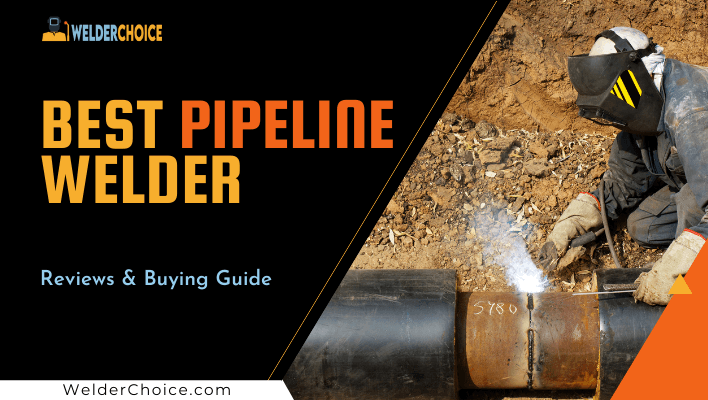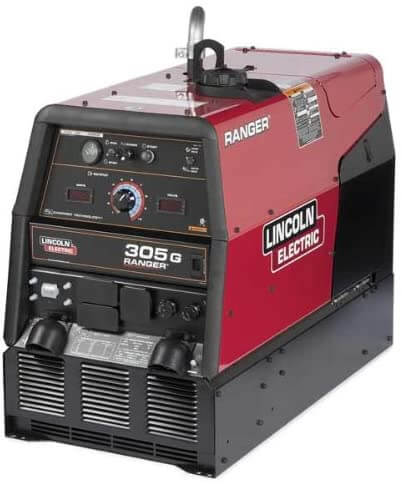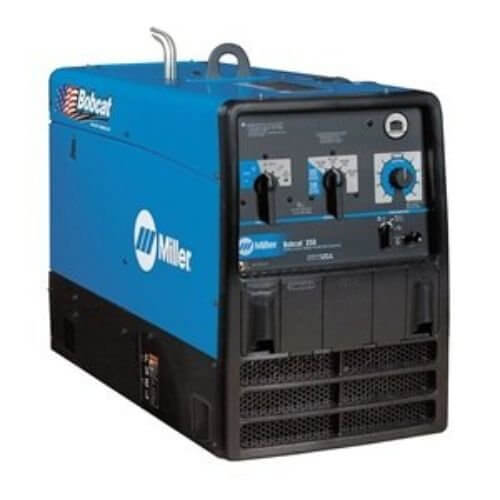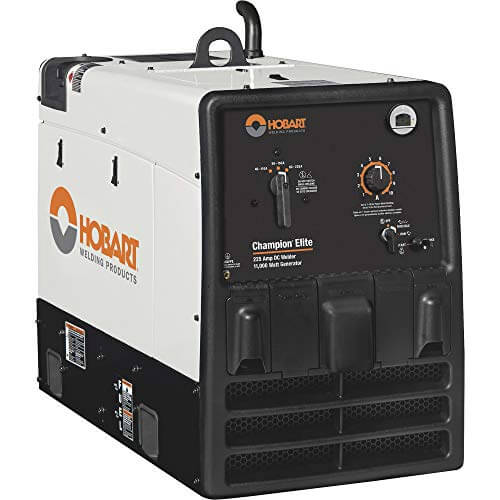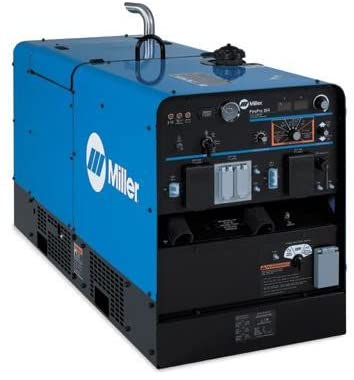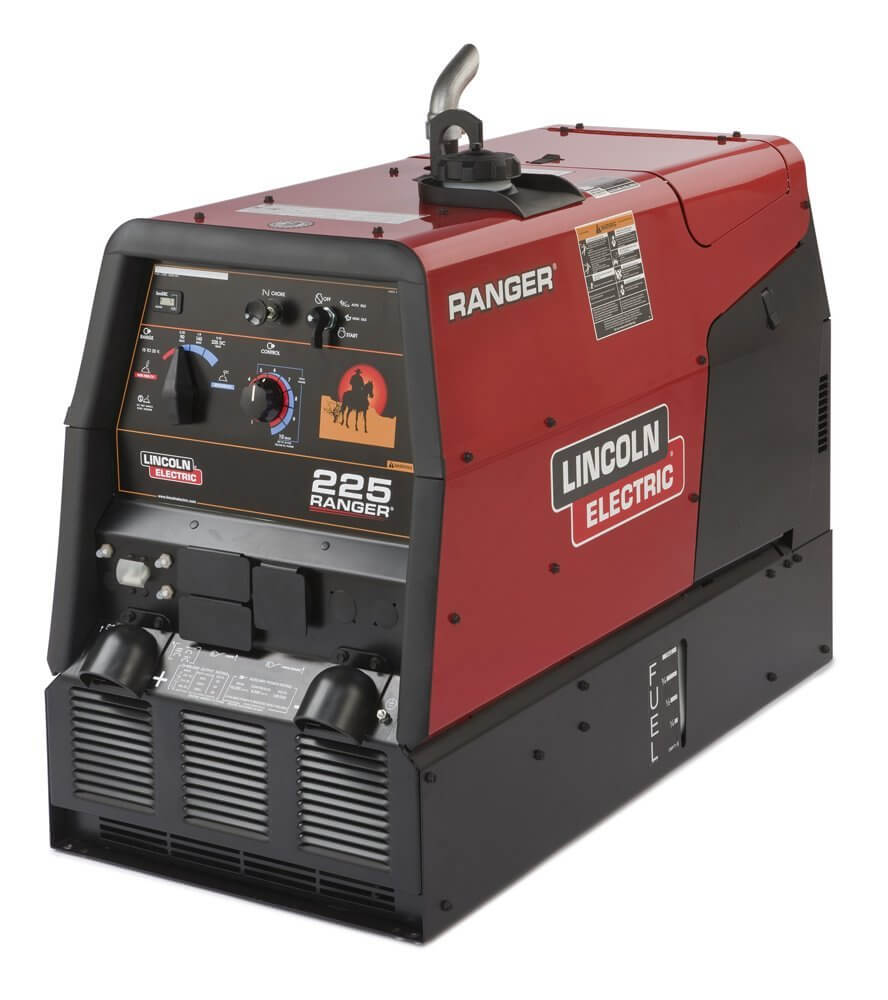One of the cornerstones of contemporary society is pipelines. They’re necessary for the movement of vital fluids like gas, oil, and water, among others, and their failure has a considerable influence on transportation, commerce, and family comfort. Driving to work, heating your home, and even cooking would be difficult.
People who install, repair, and maintain pipelines may pique your interest. These are pipeline welders, and there is a growing demand for them all across the world.
Pipeline welding may appear to be a low-skilled, high-paying welding career, but it actually requires substantial training and a strong skill set. As a result, hang tight as the article goes through various pipeline welding features as well as a review of some of the best pipeline welding machines professionals should consider.
Top 5 Pipeline Welding Machines
Without further ado, here we listed the best Pipeline welder.
1. Lincoln Electric Ranger 305G
2. Miler Bobcat 250 Engine-driven
3. Hobart 500562 Champion Elite Welder Generator
5. Lincoln Electric Ranger 225 Welder
Best Pipeline Welder Reviews
This article is about we reviewed the best Pipeline welding machine with specifications and their Pros and Cons that represents the worth of the best pipeline welders.
Let’s start the review of the best Pipeline welding machine.
1. Lincoln Electric Ranger 305G Welder
Key Features:
- The rotor has a skewed design
- Downhill pipe welding modifications
- 9500 Watts of power continuous
The Ranger 305 welding machine flagship from Lincoln Electric has long been considered one of the most famous names in the welding industry. The Ranger 305 welder is one of the best pipeline welder which has a powerful engine-driven workhorse that can handle both light and heavy-duty welding jobs.
This welder is incredibly versatile, allowing you to perform TIG, MIG, flux-cored, and stick welding, among other techniques. Welding is possible on steel, cast iron, and stainless steel pipelines. A robust enclosure protects the Ranger 305’s components from adverse environmental conditions.
A 23-hp Kohler air-cooled 4-cycle, 2-cylinder gasoline engine with a 12-gallon fuel capacity powers this pipeline welding machine also allowing you to use it all day. It also has an AC generator with a constant output of 9.5 kW and a surge output of 10.5 kW, which is sufficient to run power equipment like grinders, lights, and other tools on the job site.
The Linclon Ranger 305 welder has a duty cycle of 100% at 305A. The single, full-range output control knob takes the place of complicated knobs and taps, allowing you to input the power you want. This is made easy by the dual output meters, which also indicate the real output voltage and amperage.
Pros
- A machine is capable of a wide range of welding procedures.
- Digital meters make it easy to measure output power.
- wattage rating that is higher
- Both DC and AC power outlets can be used.
Cons
- Quite a bit heavier than the rest of the field.
- A separate wire feeder is required for flex-cored welding.
2. Engine-driven Miller Bobcat 250
Key Features:
- Starter type: electric
- Amperage range: 40 to 250
- fluxes cored and stick Welding
Second on our list is the Miller Bobcat 250, a multi-purpose engine-driven welder available in diesel, propane, and gasoline versions. It supports flux-cored, MIG, TIG, aluminum, and stick welding, as well as plasma cutting.
On restricted job sites, the machine’s lightweight design makes it easier to transport while still providing additional space for accessories and other instruments.
A 23-horsepower Kohler CH 730 twin-cylinder engine powers the Bobcat 250. It comes with a 12-gallon fuel tank to extend your welding sessions. An onboard single-phase generator supplies 9.5 kilowatts of continuous power and 11 kilowatts of maximum surge power to the pipeline welder.
Miller Bobcat 250’s amperage range is 40 to 250 amps, allowing you to work on both simple and complex projects. With a maximum output of 250A, you can easily weld thicker pipelines.
The Miller Bobcat 250 welder‘s low noise level is another feature you’ll like. This best pipeline welding machine allows for effective on-site communication while also providing a nice working environment for your personnel.
Pros
- Fuel capacity that lasts up to 14 hours
- A more lightweight and quieter design
- The 250A output will help with heavy-duty tasks.
- Both DC and AC outlets can be used.
Cons
- It costs a little more than some of its competitors.
Recommended Post: Best Arc Welders
3. Hobart 500562 Champion Elite Welder
Key Features:
- 23 HP Kohler twin cylinder 4-cycle OHV engine
- Continuous 9,500 watts
- 4-cycle OHV engine
The Hobart 500562 Welder provide you with extended, dependable service and stamina because of its heavy-duty construction. It’s protected by sturdy housing that includes circuit breakers, strong electrical connections, and a large battery.
The Hobart 500562 is powered by a gas-saving 23HP Kohler 4-cycle, 2-cylinder OHV engine. With a 12-gallon tank, you can go longer between refuellings. For engine protection, the machine incorporates an automated low oil pressure cut off as well as automatic oil servicing scheduling (every 100 hours).
The generator’s peak output of 11 kilowatts and continuous output of 9.5 kilowatts provide enough single-phase power to run hand tools, lighting, pumps, compressors, and other job-site machinery.
Its 40-225A range allows you to tackle a wide range of tasks, and its high power allows you to weld materials up to 1.5 cm thick in a single pass. This Hobart 500562 Welder is American-made and capable of welding stainless steel, speciality metals, and steel. It is has three-year warranty.
Pros
- It’s possible to weld using both AC and DC power.
- High-quality construction
- On-site auxiliary power is accessible for the use of additional devices.
- It can power an entire house, including an electric dryer, a hot tub, an oil furnace, and a good pump, among other things.
Cons
- battery won’t last long as the machine.
- Welding leads not included
4. Miller PipePro 304 welder
Key Features:
- Maximum Voltage: 230 Volts
- Output Amperage: 300 Amps
- There are diesel engines in use.
The Miller PipePro 304 welder is a flexible multi-process welder that can do plasma, TIG, MIG, flux-core, and stick operations. This model’s most significant feature is that it is the world’s first engine-driven welder that can work independently of the engine when connected to a single-phase 230V line or three-phase power via the dual power connector.
The Miller PipePro 304 is the best pipeline welding machine that can handle heavy-duty tasks with ease, thanks to its maximum amperage output of 300. The dual digital ammeter and voltmeter can be used to control the machine’s output.
This Miller Electric flagship is powered by a Kubota diesel engine. Because of the dual power input, which combines both electric and engine power, this machine can be used anywhere with or without access to mains power. Other tools on-site or during power outages can be powered by the 12-kilowatt generator.
You won’t have to worry about loading Miller PipePro 304 sideways on a regular pickup truck because it’s tiny. Furthermore, its small size makes it an excellent choice for performances in congested settings. The PipePro 304, like its Miller Electric predecessor, the Bobcat 250, is known for its quiet operation.
Pros
- it has dual power, you can use it anywhere, even in the most remote regions.
- It takes up less space on construction sites.
- Minimal noise
- you Can weld with a variety of techniques
Cons
- Despite its small size, it is much hefty than it appears.
Recommended Post: Best 110V MIG Welder
5. Lincoln Electric Ranger 225 Welder
Key Features:
- 10,500 watts of peak generating power; 9000 watts of continuous power
- 100 percent duty cycle, 210 amps/25 volts
- Kohler engine, 2-cylinder, 4-cycle, 23 HP
Thanks to its 50-225 amperage range, the Lincoln Ranger 225 welder is another Lincoln Electric multi-process and multi-purpose welder that can handle a variety of welding processes, including TIG, MIG, stick, and flux-core welding.
This best pipeline welder is powered by a low-maintenance 23HP Kohler 4-cycle twin-cylinder OHV (overhead valve) air-cooled engine. Every 100 hours, the oil must be changed, and the oil filter must be replaced every 200 hours. Oil changes are simple with the oil drain extension, and the 12-gallon tank allows you to run for extended periods of time.
The 1-phase AC generator delivers 9.5 kilowatts of continuous power, which is suitable for running lights, grinders, and plasma cutters.
For convenient access, the Lincoln Electric Ranger 225 is housed in a case with three doors. A fuel level gauge is included on either side so you can monitor how much petrol is left in the tank. During critical projects, this reduces the requirement for emergency fuel.
Pros
- High amperage provides for thick pipelines
- The welder is equipped with a powerful engine and a large fuel tank that allows it to operate for several hours.
- It’s versatile
- Design with a closed-door
Cons
- Little Heavy
A Buyer’s Guide
Here we some up the points that should follow when you buy the Best pipeline welder.
Pipeline Welding: What Is It and How Does It Work?
The majority of people can’t tell the difference between a pipeline welder and a piping welder. Someone who works on the piping systems in industrial settings such as chemical factories and oil refineries is known as a piping welder. Here, you’ll find a range of different-sized pipes made of diverse materials.
Distribution pipelines, which can be hundreds of kilometres long and transport oil from oil rigs to refineries or gas and oil from refineries to terminals, are the most common places where pipeline welding is employed.
Pipeline welders work with pipes whose contents, if handled incorrectly, might be dangerous. To ensure that projects are carried out and completed correctly, they must adhere to specific guidelines. It’s vital to use the proper materials, equipment, and safety requirements while also considering the needs of the employer.
Pipeline welders are in charge of a wide range of tasks. They must be able to read and grasp pipeline construction plans, as well as use the proper amount and type of supplies. Pipeline welding also entails following designs when installing and repairing pipelines, as well as evaluating the completed system for airtightness and waterproofing.
You’ll need to know how to use a range of tools as a pipeline welder, including torches, filler rods, welding machines, grinders, straightedges, callipers, wrenches, and drills. The majority of these tools are required for the preparation and performance of welding.
Assessment is also part of the pipeline welder’s job description. They must ensure that workpieces are defect-free and meet all standards. You must keep the welding machines and other gear in good working condition as a pipeline welder, even if that involves servicing them on a regular basis.
Pipeline Welding Working Sites and Conditions
Pipeline welders are critical in the petroleum industry. This personnel ensure that every pipeline installation in the industry is functional and safe, whether they are working on oil rigs, refineries, or oil terminals. The pipelines that connect these structures are likewise installed, repaired, and maintained by the specialists.
Pipeline welders can also work in the following industries:
- Automobile manufacturing
- Nuclear energy production
- Manufacturing facilities for aerospace products
- The military forces
- Construction sites
Welding comes with a high risk of injury and illness. Welding equipment produces a lot of bright light, which might harm your eyes. Keep in mind that some welding tools produce a lot of heat, as well as the danger of inhaling welding fumes. As a result, it’s vital to wear protective gear and follow all safety regulations.
Pipeline welding, on the other hand, raises the bar by presenting more challenging working conditions and environments. Working at awkward angles and holding your equipment in unexpected postures has traditionally been a requirement of this employment. You may be asked to work on projects in harsh climates such as deserts or polar regions.
Underwater pipeline welding takes the cake when it comes to the most demanding welding projects. Welders work in an atmosphere where they would perish if they didn’t have specialized equipment.
Underwater welding requires dry, pressurized cages, but poor light, water bubbles, and cold temperatures can make the job more difficult. This, on the other hand, has to be the highest-paying welding position.
Requirements for Pipeline Welders
Pipeline welding should not be attempted without first having adequate training and learning the appropriate abilities. Higher-than-average welding skills, which can only be gained through formal schooling, are required while working in more difficult angles and conditions.
Most pipeline welding students begin by completing a formal apprenticeship, which requires at least 144 hours of classroom instruction and 2000 hours of full-time work. This might take anywhere between three and five years.
You can also enrol in trade school classes to learn basic welding techniques, such as:
- Shielded Metal Arc Welding (SMAW)
- Gas Tungsten Arc Welding (GTAW)
- Submerged Arc Welding (SAW)
- Flux Cored Arc Welder (FCAW)
- Vertical Down Electrodes with Low Hydrogen in SMAW
You’ll also learn how to design pipe systems, use tools, understand metallurgy, draw mechanically, and stay safe.
Technical skills and expertise may not be enough to earn a license, prompting the need for certification programs. The American Petroleum Institute, the American Society of Mechanical Engineers, and the American Welding Society are just a few of the main American organizations that offer welding credentials. It’s worth noting that pipeline welder licensure requirements vary per state.
Welders who work offshore must do an offshore survival skills course as well as helicopter underwater escape training. Workers must pass an offshore medical examination, thus this is not a job for anyone with major health issues. It’s also likely that you’ll be forced to take safety training unique to your firm.
The detection and resolution of pipeline system problems will be aided by problem-solving ability. In order to effectively articulate ideas, engage with coworkers and employers/employees, and offer detailed and valuable reports, pipeline welders need also to have strong communication skills.
Physical stamina is essential to tolerate the hard working conditions connected with this job. Pipeline welders must also travel frequently, so if you dislike travelling, this may not be the job for you.
Pipeline Welding Salary
Few people appreciate the harsh working circumstances that are common in pipeline welding, but there are plenty of opportunities for those who are willing to take on the challenge. As a result, pipeline welding has become one of the most lucrative welding jobs on the planet.
Pipeline welders working in natural gas distribution corporations received an average yearly wage of $78,970 in 2018, according to the US Bureau of Labor Statistics, while those working in other pipeline transportation industries earned up to $75,690. The average hourly wage is $34, with the highest-paid employees earning more than $60.
Pipeline Welding Machines
Your good abilities, expertise, and experience won’t help you much in your pipe welding job if you don’t have the correct equipment. You should be aware that you will be welding extremely thick pipelines infrequently challenging conditions. Without a doubt, not all welding equipment is capable of fulfilling pipeline welding’s needs and problems.
One of the most basic components of pipeline welding equipment is a welding machine. A strong welder that satisfies the amperage requirements is required for pipeline welding. Furthermore, because the majority of duties are done outside, a machine with a portable power source that can also power other devices is required.
It’s tough to find a pipeline welder who can easily meet these specifications while still delivering outstanding results. Fortunately, whether you’re just getting started or replacing an older welder, we’ve compiled a list of the best options to consider before making your next purchase. Let’s start by talking about how to choose a pipeline welder.
What to Look for Pipeline Welding Machines
Output Power
The power of the best pipeline welding machine is represented by the output ampere number. Because pipelines come in a variety of thicknesses, you’ll want to buy a welder that can handle a number of tasks.
A range of 120 to 140 amperes will suffice for residential use, but more power ranging from 200 to 300 amperes would be required for more demanding jobs. Select a machine that can generate a wide range of outputs.
You’ll need a stable power source because you’ll be using your computer outside most of the time. A built-in generator is standard on most pipeline welders, which can keep the machine running for up to a day.
Duty Cycle
In layman’s words, the duty cycle is the proportion of minutes in a 10-minute period when a welding machine can produce a given current without overheating.
Consider a welding machine with a current rating of 150 amps and a duty cycle of 70%. This means you must rest the equipment for at least 3 minutes after welding at 150A for 7 minutes. Using lower amperage results in a higher duty cycle. As a result, if you utilize 100A, your duty cycle might be as high as 85%.
For the power output you want for your requirements, choose a welder with the maximum possible duty cycle. Most professional welding equipment produces a 100 percent duty cycle for outputs as high as 250A.
Versatility
Multiple welding procedures are required since pipelines come in a variety of thicknesses and materials. The most common processes include Metal Inert Gas (MIG) welding, stick welding, flux-cored welding, and Gas Tungsten Arc Welding (GTAW), also known as TIG (Tungsten Inert Gas) welding.
TIG is better suited to thinner components or smaller projects, whereas MIG is better suited to larger, thicker pipelines. You don’t want to be restricted by the scale of the project or the thickness of the pipe, so a welder who can do all of the operations is essential.
Safety
As much as you want a powerful computer, you also need to consider its security features. Surge protection in pipeline welders is an important safety feature to look for. Between 20 and 25% is the best level of protection.
Portability
Pipeline welding is a highly mobile job that necessitates a lot of moving about and pulling welding equipment. For pipeline welding jobs, this entails the procurement of a portable machine.
Although a portable welder is compact and light, it must be sturdy enough to withstand constant movement and hard conditions.
Conclusion
Here we conclude our guide of best pipeline welder.
The demands and risks of pipeline welding are the basis for the rigorous training you’ll need to complete before becoming a competent welder. On the other side, pipeline welding is one of the highest-paying positions in the welding industry.
Welding pipelines demands a lot of power, so people who wish to stay active in this field should invest in high-quality equipment.
Our top pick is Lincoln Electric Ranger 305G Welder which owns the high versatility and quality.
When picking the best pipeline welding machine, look for the qualities outlined in this article as well as user reviews on online platforms. You can be confident that with the best pipeline welding machines reviewed above, you will be able to execute a wide range of operations with ease and obtain the desired results.
